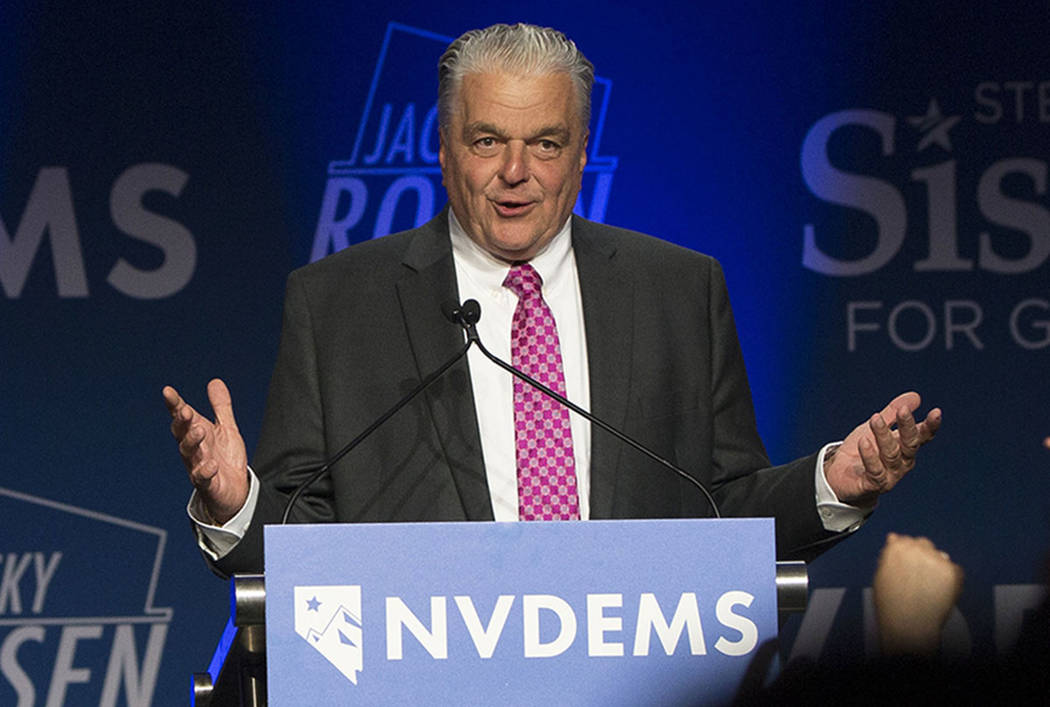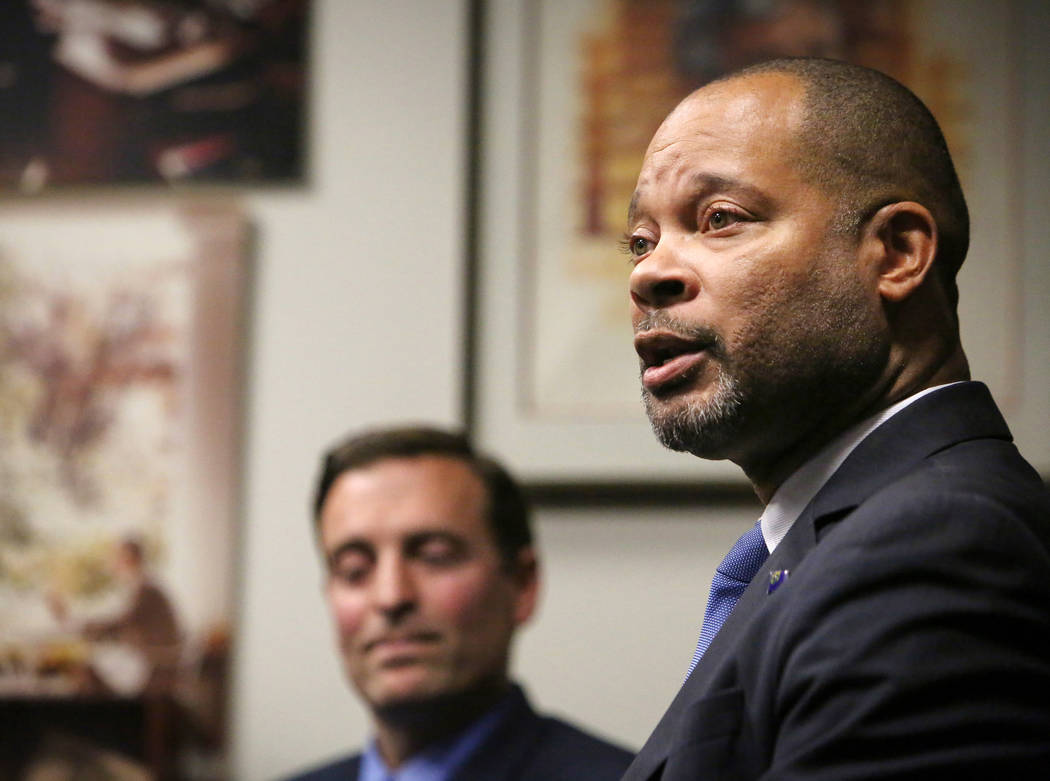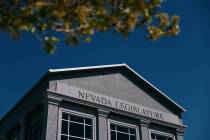Nevada’s Democratic wave comes ashore in Carson City
CARSON CITY — When Gov.-elect Steve Sisolak and other state officeholders are sworn in on Monday, Democrats will assume control of Silver State government to a degree not seen since at least the early 1960s — perhaps, by a slightly different reckoning, the 1930s.
By either measure, the significance of that transition is not lost on the person who will be the center of attention on Nevada’s Capitol steps come Monday.
“It’s obviously a big time for Nevada,” Sisolak said Friday, traveling by car on a tour of the state en route to the capital from Las Vegas. “An incredible blue wave came through, and we got a lot of good people elected: a lot of Democrats, a lot of females. There’s going to be a female (legislative) majority, the first state that’s ever had that. I’m just hopeful that we’ll be able to get to work quickly.”
Consider what changes Monday:
• Democrats will hold the governor’s office for the first time in 20 years.
• They will hold more statewide constitutional offices, five of six, than at any time since the mid-1960s.
• They will hold a government “trifecta,” the governorship and both houses of the Legislature, for the first time since the early 1990s. That’s a complete reversal of the same advantage Republicans enjoyed only four years ago.
The last time Democrats enjoyed all three advantages — full control of the Legislature, the governorship and a majority of other statewide offices — was the mid-1930s.
With that level of dominance, change is likely to happen fast, as it has in other states that saw similar electoral U-turns in November.
Sisolak is one of seven new Democratic governors elected two months ago. His counterparts in Michigan and Maine, already sworn in, have wasted no time. Maine Gov. Janet Mills quickly reversed her Republican predecessor to begin the state’s expansion of Medicaid under the Affordable Care Act, and Michigan Gov. Gretchen Whitmer issued a series of rapid-fire executive directives to improve government transparency, strengthen ethics and increase accountability.
“You don’t become a Democratic governor of Kansas or the Democratic governor of Michigan or Maine and not have a mindset about needing to get things done,” said David Turner, deputy communications director for the Democratic Governors Association. “That’s the reason these folks were elected. Same with Nevada.”
Sisolak said: “We are planning on doing some things quickly and I’ll let you wait until Monday to see what’s that’s going to be.” But the governor-elect has made a significant opening move even before his swearing-in. With incoming state Attorney General Aaron Ford, the two have pledged that Nevada will join other states to fight a Texas federal judge’s Dec. 14 ruling invalidating the Affordable Care Act.
As for other policy disputes that could draw state-level Democrats into battle with President Donald Trump, Sisolak said he trusted those fights to the state’s federal officeholders. Democrats now hold both of Nevada’s U.S. Senate seats for the first time since 2000 in addition to the three of four U.S. House seats they’ve held for two years.
“I’ve got my hands full with Nevada, and that’s where I’m going to focus my energy,” Sisolak said.
A united executive branch
The cooperation already evident between Sisolak and Ford, as seen in the joint statement on the ACA ruling, also signals what will be a noticeable change for state executive government. Their Republican predecessors, Gov. Brian Sandoval and Attorney General Adam Laxalt, who lost the governor’s race to Sisolak, were not on the same page ideologically. The two Democrats are, and the two offices will work together much more closely.
As for what lies ahead under a new attorney general, Ford takes the state’s top law enforcement job Monday as the first African-American elected to nonjudicial statewide office. Besides joining other states in defense of the ACA and fighting further attempts to resuscitate plans for nuclear waste storage at Yucca Mountain, Ford has pledged enhanced policing of consumer protections, environmental issues and the “rights of Nevada families,” sort of a catchall phrase for a range of topics that includes immigration, equality and civil rights.
Ford said Friday that he has yet to review the full scope of legal action Nevada might initiate, join or abandon under his tenure, but it is likely that Nevada will sign on to parts of the existing raft of multistate litigation against the federal government. Two years into the Trump administration, there are 67 such lawsuits, overwhelmingly from Democratic-controlled states.
That compares with 62 lawsuits during all eight years of the Obama presidency and 44 during eight years of President George W. Bush.
Nevada joining those actions is “more of a piling-on,” said Paul Nolette, a professor at Marquette University in Wisconsin who follows legal profession politics and tracks state-federal relations. But Democrats, who with a pick-up of four attorneys general posts hold a 27-23 advantage over Republicans, can now claim to represent a majority of states, electoral votes and total population.
“Given the fact that immigration has been obviously a huge hot-button issue on the national stage, it will be interesting to see what direction Ford goes on that issue, given that it’s a particularly important issue for Nevada,” Nolette said.
Labor issues are also a potential priority for Ford, Nolette predicted, given the relative strength of unions in the state.
Is the change all that?
By one measure, the state government that takes office Monday reflects an extraordinary reversal of fortune for a party that in 2014 was on the losing side of the trifecta calculus. The 2015 legislative session was the high-water mark for roughly two decades of Republican ascendancy at the state level in Nevada, although Democrats held for six years starting in 2009 and four lesser state offices for eight, starting in 2007.
Viewed from a different angle, however, gains Democrats made in Nevada more reflect trends that played out in several states on Election Day. Indeed, there was the typical midterm disaffection toward the president and the party in power. But voters also telegraphed a general weariness with government gridlock and partisan infighting.
“The election ended up unifying a lot of state governments under one party,” said Kyle Kondik, managing editor of Sabato’s Crystal Ball, a nonpartisan newsletter from the University of Virginia’s Center for Politics.
Among state legislatures, only one, Minnesota’s, has divided-party control, not counting Nebraska’s unicameral, nonpartisan Legislature. There are 22 Republican government trifectas and 14 for Democrats, with 13 states divided. Two years ago, there were eight divided legislatures and 19 divided state governments.
“It was generally a good year to be a Democrat nationally,” Kondik said. “I think there’s been this idea that Nevada was clearly trending to become a blue state. That may be what the longer trajectory is, but I don’t think we’re there yet.”
On Friday, Ford pointed to the electorate’s desire for change and noted the precedents here: his victory, the seating of the nation’s first majority-female legislature, and African-American leadership of both houses of the Legislature, with one of those leaders being openly gay.
“These types of things reflect that in Nevada we have an appreciation for diversity, not just in gender and in race but also in thought,” Ford said. “And when you bring together people in the way that Nevada has and the way that, writ large, the national election demonstrated, then you have a better opportunity to represent everybody.”
Contact Bill Dentzer at bdentzer@reviewjournal.com or 775-461-0661. Follow @Dentzernews on Twitter.



















